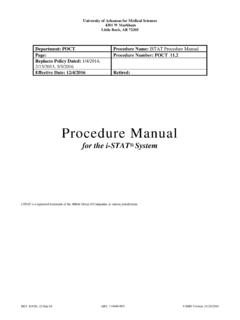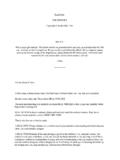Transcription of LABORATORY SAFETY PLAN INFECTION CONTROL IN THE …
1 LABORATORY SAFETY plan INFECTION CONTROL IN THE CLINICAL LABORATORY PART 1. GENERAL SAFETY STANDARDS Smoking is prohibited at UAMS and all campus buildings. No food or drink will be stored in refrigerators in the LABORATORY work area. Application of cosmetics is prohibited in the LABORATORY work area. Hair should be worn or secured so that it cannot become either a SAFETY hazard or a source of contamination. Beards require the same precautions. Open cuts and broken skin must be covered with a suitable means of protection, such as gloves, to avoid the risk of contamination and possible infections .
2 Personnel must have annual TB screening. Personnel are encouraged to receive the Hepatitis B vaccine offered through the Student/Employee Health Service. ALL personnel must wear lab coats while at work. These coats must be left in the lab when going to lunch, on breaks, or when leaving at the end of the shift. PART 2. HANDWASHING Hand-washing is considered the most important single procedure for preventing and controlling the spread of INFECTION . Proper hand-washing has been shown to eliminate or greatly reduce hand carriage of pathogens.
3 There are two types of hand-washing to be used in the LABORATORY : routine and antiseptic. ROUTINE is used: When coming on duty Before and after eating Before and after using the restroom Before going off duty ANTISEPTIC is used: After contact with contaminated objects After contact with patient specimens, particularly Blood and Body Fluid Precaution specimens After removal of protective gloves HANDWASHING PROCEDURE: A. ROUTINE: 1. Wet hands under running water 2. Keep hands lower than elbows, apply SOAP 3.
4 Work into a lather scrubbing fingers, palms, backs of hands, wrist and forearms creating friction for at least 15 seconds. Cleaning under nails should be attempted. 4. Thoroughly rinse hands under running water 5. Use paper towels to blot and dry hands 6. Use dry paper towel to turn off faucet, then discard B. ANTISEPTIC: 1. Follow the procedure for routine hand-washing, but use an ANTISEPTIC product instead of soap. PART 3. PROCESSING SPECIMENS SUBMITTED TO THE LABORATORY All specimens received in the UAMS Anatomic Pathology Department will be handled in accordance with practices set forth by the Occupational Exposure to Bloodborne Pathogens; final rule of December 6, 1991.
5 All specimens are to be received in a closed container or plastic bag with the appropriate patient information attached. All tissues for a pathological examination, dissection, sectioning, and gross description shall be places in one of the four provided exhausted cutting stations prior to removal from it container before any of the mentioned procedures are started. All cytology specimens are opened and processed under the biological SAFETY hood. The cryostats used for frozen section shall be cleaned and disinfected with 95% ETOH.
6 The four cutting stations shall be rinsed and cleaned of bloody fluids and tissue debris in between cases as the need arises. The cutting stations should be cleaned thoroughly at least once a day with a 20% bleach aqueous solution with liquid hand soap added. This comprehensive cleaning which will include other possibly contaminated areas of the laboratories should be performed at the beginning or at the end of each working day. Heavily soiled contaminated areas may require more frequent cleaning. All sharps including scalpels tissue prep blades, needles and discarded glass slides are to be disposed of in a suitable biohazard marked sharps container.
7 All disposable glover, paper towels, empty specimen containers and personal SAFETY equipment shall be disposed in a biohazard red plastic bag for incineration. All linen soiled with blood and body fluids are washable personal SAFETY apparel should be placed in a biohazard marked linen hamper for laundering. Upon leaving the laboratories all personnel shall remove, store and dispose of all personal SAFETY equipment in the appropriate fashion. Lightly soiled fluid impermeable nylon surgical gowns may be stored upon exit and reused on return to the laboratories.
8 The required personal equipment worn in the LABORATORY is as follows, but not limited to: 1. Fluid impermeable nylon surgical gowns, smocks or LABORATORY coats. 2. Surgical or examination gloves 3. Eye goggles 4. Polyethylene disposable aprons In addition, shoe covers and head covers are provided and used at the discretion of the LABORATORY personnel. All cutting instruments, forceps, rulers and applicable dissection equipment should be washed in a 20% aqueous bleach solution with liquid hand soap, dried and stored in a dry state until further use.
9 Frequent debridement and rinsing of dissecting equipment is encouraged throughout the day to prevent cross contamination of surgical specimens as dictated by good LABORATORY personnel. Any technicians, residents or other parties dispensing fixatives, cleaning solutions and reagents are required to wear at the minimum protective eye wear, gloves and a polyethylene apron. The LABORATORY support staff shall , at the minimum, be required to wear gloves, an impermeable disposable gown or a disposable polyethylene apron.
10 PROTOCOL FOR LABORATORY EMPLOYEE PROTECTION PART 1: HEPATITIS B EXPOSURE Hepatitis B immune Globulin is now available to those LABORATORY employees and students, who accidentally come into contact with a patient s blood which is confirmed positive to Hepatitis B Virus. Examples of common LABORATORY accidents which my qualify one for protection with Hepatitis B Immune Globulin include: Accidental Needle Stick Direct Mucous Membrane Contact (mouth/nose/eye) Oral Ingestion (pipetting accident) Open Wound Contact (accidental splash) Cut Finger (from blood contaminated tube) If one has such an accident involving blood, plasma or serum from a SPECIFIC IDENTIFIABLE PATIENT, he should report immediately to his supervisor.




